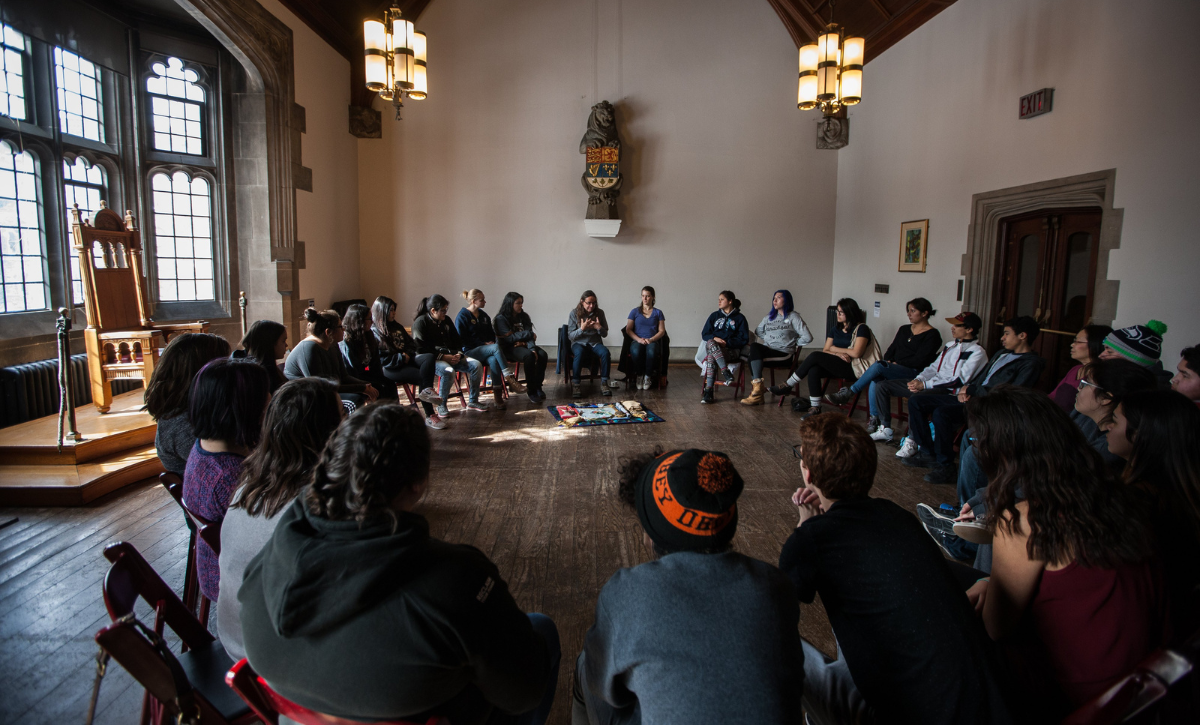Remembering How to Be Friends: Amid COVID Isolation, One School Is Using Talking Circles to Help Kids Reconnect
Rooted in Indigenous ceremony, circles are helping Texas students restore their school community

Get stories like this delivered straight to your inbox. Sign up for The 74 Newsletter
Life lines in Austin: Combatting the teen mental health crisis — After two years of fear and isolation among teens across the country, suicide attempts among adolescents are up along with substance abuse rates. Anger and despair are palpable in middle and high school hallways, students say, as the pandemic’s youth mental health crisis rages. But counselors, mentors, and teachers in Austin, Texas, have developed a plan, strategically deploying resources targeting suicide, teen alcoholism, social isolation. The approach is working. Teens and adults say they are seeing glimmers of hope. In this series The 74 looks at three pre-pandemic programs offering lifelines to students in their late-pandemic distress.
Like so many of her peers returning to classes after two years of pandemic isolation, Crockett High School senior Klyrissa Porter often feels overwhelmed.
But the Austin, Texas, teen noticed when she would reach out to her friends to share that her mental health was suffering, the replies she received were not exactly what she’d hoped for.
“They’d just be like, ‘LOL, same,’” Porter said.
The hallways are full of teens struggling, she said, but no one seems to be able to help anyone else move forward. “Everyone is going through a lot, and because of that we’ve forgotten how to be friends,” she said, “…to be there for each other, support each other, love each other.”
That’s particularly difficult for Porter who has been part of Students Organizing for Anti-Racism (SOAR) since her freshman year to help confront the systemic racism at school. But confronting such large troubling issues on campus requires stamina people seems to have lost during the pandemic, said students in SOAR, which meets as a regular class at Crockett.
To honor diverse perspectives, they first have to relearn how to hear and see beyond themselves.
“There is not a person in the world who doesn’t have something they’re going through,” Porter’s classmate, senior Lilly Swearingen said.
Now, the same skills they use to ground their anti-racist work are helping the SOAR students rebuild the basic social skills and healthy relationships they lost during the pandemic.
Specifically, they said, circles have helped them repair their relationships and see themselves in the context of community again.
When the students in Crockett High School in Austin gather to address conflict or deepen their connection to each other, they usually gather in a circle and pass a talking piece from student to student while answering a question or responding to a prompt.
These circles, familiar fixtures in social and emotional learning and restorative discipline, have sacred roots, said Iztac Arteaga, the restorative practices specialist at Crockett. Circles have been healing and grounding for Indigneous communities for centuries, and their power is more vital than ever in the middle of a nationwide teen mental health crisis.
“When people feel held and seen and valued as humans, there’s just so much more that can be done as you’re navigating difficult situations,” Ateaga said.
Difficult situations abound.
As Arteaga teaches students and teachers how to participate in and eventually facilitate circles, she is adamant that the practice not become perfunctory or sloppy. While it’s tempting to just, for instance, grab a dry-erase marker to serve as a talking piece, she said, for a circle to be most effective, it also has to be, in some sense, sacred.
“If we knew the history and how indigneous people literally died and lost their lives to maintain these practices we’d probably treat it with a little more respect,” Arteaga said.
Instead of a dry-erase marker for a talking piece, the group should choose something to convey respect, and remind them of their shared values. Same with the centerpiece, where students can rest their eyes if looking at each other becomes uncomfortable or painful.
In her position, Arteaga facilitates and teaches “community-building” circles, which start out light, giving people the opportunity to know each other. Cross-talk and phones are not allowed. She also does trauma-informed “mediation” circles when a conflict has occurred between students or between students and teachers.
When they returned to school, the first emotion Porter noticed was anger. Fights broke out, people lost their tempers daily. “It got to the point that we were scared to come to school,” she said, as other students nodded along with her.
Circles at Crockett are uniquely suited for these complicated dynamics. While punitive discipline might address the behavior, restorative practices like those students learn in SOAR, speak to the pain behind the outbursts.
“SOAR gives us a place to express ourselves, and a space where everyone can just say what they need to say,” said junior Daniella de Guzman.
Community circles gather students to address harm done and feelings hurt, but instead of doling out punishments according to a policy handbook, each member of the circle can say what they need. Even the offending party gets the chance to express the unmet needs or pain that led to their hurtful actions. Addressing the pain keeps them in the community, and accountable to it.
Arteaga knows the power of circles to sustain community, not just as a facilitator in schools, but as a participant. As an Indigenous person whose ancestors were colonized out of their home and identity, ceremony is critical to her understanding of her own heritage. She participates in circles with the broader Indigenous community in Austin, and confers with the people there about how to best facilitate the practice in schools.
It’s a careful balance, she said. Some aspects of ceremony need to be exclusive to Indigenous communities, because of the long history of cultural appropriation.
Circles are a sacred part of the governance, community preservation, and identity of Indigenous groups, Arteaga explained, and were part of the religious and cultural practices outlawed for most of the history of the United States until the 1978 American Indian Religious Freedom Act.
While she recognizes the circles happening at school will be inherently less authentic to Indigenous culture—the circles in the SOAR class are named after the houses in the Harry Potter series—Arteaga wants them to be respectful of it as they gather around a centerpiece—often a fire—and designating a talking piece to pass from person to person.
“If we knew the history and how Indigenous people literally lost their lives to maintain these practices, we probably would treat it with a little more respect,” Arteaga said.
While she sometimes has to educate students and teachers simultaneously, the teacher for the SOAR class had the kids well-versed and acclimated to circles, Arteaga said. With the additional grounding in history and tradition, the SOAR students have been able to facilitate on their own. Her goal is for more students and adults on campus to be able to do the same, so that circles become a regular and reliable resource. Skilled listeners and communicators can strengthen the entire support network of the school.
Freshman Will Haskell actually did learn a lot about himself during the pandemic, he said, and he knew that what he’d learned about his own mental health would help his friends, but after two years online, starting the conversation in person is challenging. “SOAR has helped me to be able to actually talk about it,” Haskell said.
Knowing how to offer help is one skill the kids are developing, so is asking for help. Circles teach them the importance of asking for consent in both roles.
A lot of kids seemed totally dissociated— disconnected from their thoughts, feelings, and emotions, Swearingen said. They shove the feelings down to make it through the day, and some then overshare with their friends online. She calls it “trauma-dumping” and says it’s almost a trend now.
When one person posts about a mental health challenge, she said, their comments will often fill with others echoing the complaint, or even seeming to “one-up” the severity of the original poster’s distress. “If we can at least tone it down a little bit, it would help a lot.”
Even when it’s not competitive, she said, rarely do teens ask for consent before sharing their burdens via social media or direct messages. They don’t check to see if the recipient is in the right place to receive the extra weight. For two years students were isolated from each other in real life, she said, but grew accustomed to constant, around-the-clock access to one another on social media.
“It’s an expectation that has been set and it’s very uncomfortable,” Swearingen said.
Circles provide a structured way for students to listen, to see that others are going through their own struggles, without immediately hopping on board to trauma-dump. When the talking piece moves to their hands, they will have a turn.
That predictable, structured place to safely share is critical, especially for students who want to take on society’s bigger challenges, Swearingen said. “It puts us in a spot where we can be vulnerable with each other, and because we can be vulnerable together we can be productive.”
Get stories like these delivered straight to your inbox. Sign up for The 74 Newsletter

;)
